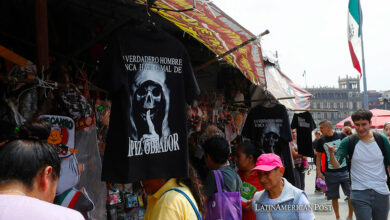The resurgence of armed gang conflicts in Cité-Soleil, north of Port-au-Prince, has triggered a fresh fuel shortage in Haiti's capital, compounding the ongoing socio-political and economic crisis marked by recurring fuel shortages

11/18/2023.- People struggle to get some fuel at gas stations in Port-au-Prince, Haiti. EFE/ Johnson Sabin
EFE
Escucha este artículo
Leer en español: Bandas armadas provocan nueva crisis de combustible en Haití
Fuel Crisis Escalates Amidst Gang Conflict in Cité-Soleil
The resumption of the conflict between armed gangs in Cité-Soleil, north of Port-au-Prince, is causing a new fuel shortage in the Haitian capital, in the midst of an ongoing socio-political and economic crisis in which fuel shortages are recurring.
Members of the armed coalition known as the GPEP have been waging an all-out battle against the G9, led by ex-policeman Jimmy Cherisier, known as Barbecue, and the clashes are affecting the Varreux port terminal, which holds 70% of Haiti’s fuel storage capacity. The other 30% is spread throughout the rest of the country.
Once again, endless queues have formed in front of gas stations and the phenomenon of the “yellow gallon”, the standard size and color of containers carried by drivers in search of fuel, has reappeared on the streets.
Protest Against Price Adjustments
In July 2023, despite numerous protests against attempts by the government to adjust the prices of petroleum products on the local market, a gallon of gasoline rose from 250 ($1.88) to 570 gourdes ($4.29), diesel went from 353 ($2.65) to 670 gourdes ($5.04), and kerosene from 352 ($2.64) to 685 gourdes ($5.15).
Although the gangs of Cité-Soleil, a community ravaged by extreme poverty and misery, announced the signing of a truce a few months ago, it has not been respected and the slum has become a veritable war zone.
Hundreds of people, both civilians and gang members, have been killed or wounded in the turf war between the CPEP and the G9 over the Varreux terminal, which supplies oil to the entire Haitian capital.
Although the Haitian government has announced that after two days of disruption, the Varreux terminal is back in operation, the resumption of service has had no impact on the fuel crisis.
Authorities Intervene as Gangs Threaten Terminal
Local authorities announced on Friday afternoon that 132 tankers had been loaded after the National Police and the Coast Guard intervened to repel the actions of the gangs stationed around Varreux.
That same day, the Varreux terminal reported that the Wineco storage center had loaded 547,750 gallons of diesel, no gallons of kerosene (compared to 3,300 the previous day), and 509,850 gallons of gasoline, according to the institution’s account on X (formerly Twitter), which had warned in previous days that no fuel was being put at the pumps.
Recurring shortages Throughout the country’s recent history, demonstrations to protest fuel shortages have scoured several governments and caused severe damage to the battered economy of Haiti, the poorest country in the Americas.
Since at least 2018, under the administration of President Jovenel Moise, who was assassinated in July 2021, the country has experienced repeated fuel shortages, always with devastating effects on the lives of citizens and institutions.
Impact on Daily Life and Institutions
With each fuel crisis, Haiti suffers a sharp increase in the price of oil derivatives, which exacerbates food insecurity, doubles or even triples the cost of public transportation, and causes the closure of institutions, including hospitals, which can no longer function because their energy source is generators running on diesel.
Also read: Zapatistas Announce Dissolution of "Autonomous Municipalities"
The shortages have also led to an increase in the informal fuel trade in the streets and neighborhoods of Haiti’s main cities, sometimes causing fires with fatalities.





